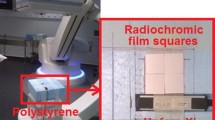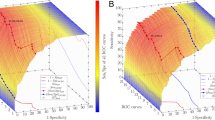Abstract
Objectives
To validate the performance of an automatic tool to estimate a patient’s peak skin dose (PSD) and a skin dose map from data collected by a radiation dose management system (RDMS) during interventional procedures.
Methods
In total, 288 eligible consecutive patients undergoing abdominopelvic embolisation or planned coronary angioplasty using radiochromic films were screened between June 2018 and March 2019. For 98 included patients, PSD was measured using radiochromic films (PSDFilm) and computed by RDMS (PSDRDMS) using one flat and two anthropomorphic phantoms. Statistical concordance between PSDFilm and PSDRDMS was computed with Lin’s concordance correlation coefficient and clinical concordance with the Bland and Altman graphic; values were compared using the paired Mann-Whitney-Wilcoxon test.
Results
In total, 190/288 patients were excluded and 98 patients were analysed (69 men, mean age 66 ± 14 years). The PSDFilm median (1st; 3rd quartile) was 0.59 Gy (0.40; 1.08). PSDRDMS was 0.62 Gy (0.43; 1.22) for the flat phantom and 0.62 Gy (0.42; 1.19) for anthropomorphic phantoms. The concordance between PSDFilm and PSDRDMS was good for both phantoms (flat: 0.94 [0.91; 0.95]; anthropomorphic 0.94 [0.91; 0.96]). Compared with the values of PSDFilm, the values of PSDRDMS were significantly increased by 5% (− 4%; 16%) for flat phantom (p = 0.001) and 7% (− 6%; 22%) for anthropomorphic phantoms (p = 0.002) for vascular procedures and 9% (− 4%; 26%, p = 0.01) and 6% (− 4%; 23%, p = 0.02) for cardiac procedures, respectively. Dose map representations matched for most patients. The gaps identified were due to table displacement during fluoroscopy events and the use of a wedge filter.
Conclusions
The RDMS skin dose map tool allowed the computation of the PSD and skin dose distribution for all patients with fewer constraints than radiochromic films. However, the computed PSD was overestimated, increasing the number of patients requiring follow-up.
Key Points
• A good concordance correlation was identified between the peak skin dose (PSD) values measured with radiochromic films and estimated with the radiation dose management system (RDMS) skin dose map tool.
• Differences were related to table displacement during fluoroscopy events and the use of a wedge filter, which are not accounted in the Digital Imaging and Communications in Medicine Radiation Dose Structured Reports.
• For all procedures, the estimated PSDs were significantly higher than the measured PSDs by 5% (− 4%; 18%) for flat phantom (p < 0.001) and 6% (− 5%; 22%) for anthropomorphic phantoms (p < 0.001).






Similar content being viewed by others
Abbreviations
- AEE:
-
Abdominal elective embolisation for renal or hepatic tumours and visceral aneurysms
- AUE:
-
Abdominal urgent embolisation for active bleeding or vascular injury from splenic, renal, hepatic, mesenteric or hypogastric arteries
- BMI:
-
Body mass index
- CA:
-
Coronary angioplasty
- CA-PTCA:
-
Coronary angiography and coronary angioplasty for one vessel
- CTO:
-
Coronary angioplasty of complex chronic total occlusion
- DICOM:
-
Digital Imaging and Communications in Medicine
- HCE:
-
Hepatic transarterial chemoembolisation with iodised oil
- ICRP:
-
International Commission on Radiological Protection
- IRP:
-
Interventional reference point
- Ka:
-
Air kerma
- Ni:
-
Number of fluorography images
- PEE:
-
Pelvis elective embolisation for planned prostatic embolisation
- PSD:
-
Peak skin dose
- PUE:
-
Pelvis urgent embolisation for bleeding from the pelvis (prostatic, cystic, trauma bleeding)
- RDMS:
-
Radiation dose management system
- RDSR:
-
Radiation dose structured report
- ROI:
-
Region of interest
- SDM:
-
Skin dose map
- SRPD:
-
Source to reference point distance
- Tf:
-
Fluoroscopy time
- UEE:
-
Uterine elective embolisation for fibroids or vascular malformations
- UUE:
-
Uterine urgent embolisation for postpartum haemorrhage
References
Balter S, Hopewell JW, Miller DL, Wagner LK, Zelefsky MJ (2010) Fluoroscopically guided interventional procedures: a review of radiation effects on patients' skin and hair. Radiology 254:326–341
Koenig TR, Wolff D, Mettler FA, Wagner LK (2001) Skin injuries from fluoroscopically guided procedures: part 1, characteristics of radiation injury. AJR Am J Roentgenol 177:3–11
Miller DL, Balter S, Cole PE et al (2003) Radiation doses in interventional radiology procedures: the RAD-IR study: part II: skin dose. J Vasc Interv Radiol 14:977–990
Shope TB (1996) Radiation-induced skin injuries from fluoroscopy. Radiographics 16:1195–1199
Vano E, Goicolea J, Galvan C et al (2001) Skin radiation injuries in patients following repeated coronary angioplasty procedures. Br J Radiol 74:1023–1031
Greffier J, Goupil J, Larbi A et al (2018) Assessment of patient's peak skin dose during abdominopelvic embolisation using radiochromic (Gafchromic) films. Diagn Interv Imaging 99:321–329
Greffier J, Moliner G, Pereira F et al (2017) Assessment of patient’s peak skin dose using Gafchromic films during interventional cardiology procedures: routine experience feedback. Radiat Prot Dosimetry 174:395–405
Greffier J, Van Ngoc TC, Bonniaud G et al (2017) Assessment of peak skin dose in interventional cardiology: a comparison between Gafchromic film and dosimetric software em.dose. Phys Med 38:16–22
Jones AK, Ensor JE, Pasciak AS (2014) How accurately can the peak skin dose in fluoroscopy be determined using indirect dose metrics? Med Phys 41:071913
Jones AK, Pasciak AS (2011) Calculating the peak skin dose resulting from fluoroscopically guided interventions. Part I: methods. J Appl Clin Med Phys 12:3670
Ying CK, Kandaiya S (2010) Patient skin dose measurements during coronary interventional procedures using Gafchromic film. J Radiol Prot 30:585–596
Bordier C, Klausz R, Desponds L (2015) Accuracy of a dose map method assessed in clinical and anthropomorphic phantom situations using Gafchromic films. Radiat Prot Dosimetry 165:244–249
Bordier C, Klausz R, Desponds L (2015) Patient dose map indications on interventional X-ray systems and validation with Gafchromic XR-RV3 film. Radiat Prot Dosimetry 163:306–318
Rana VK, Rudin S, Bednarek DR (2013) Updates in the real-time dose tracking system (DTS) to improve the accuracy in calculating the radiation dose to the patients skin during fluoroscopic procedures. Proc SPIE Int Soc Opt Eng 8668:86683Z
Magnier F, Poulin M, Van Ngoc TC et al (2018) Comparison of patient skin dose evaluated using radiochromic film and dose calculation software. Cardiovasc Intervent Radiol 41:762–771
Habib Geryes B, Hadid-Beurrier L, Waryn MJ, Jean-Pierre A, Farah J (2018) Benchmarking the DACS-integrated Radiation Dose Monitor® skin dose mapping software using XR-RV3 Gafchromic® films. Med Phys 45:4683–4692
Greffier J, Grussenmeyer-Mary N, Larbi A et al (2019) Experimental evaluation of a radiation dose management system-integrated 3D skin dose map by comparison with XR-RV3 Gafchromic® films. Phys Med 66:77–87
Greffier J, Van Ngoc TC, Agelou M et al (2016) Impact of the calibration conditions of XR-RV3 films on peak skin dose measurements in interventional radiology. Radiat Prot Dosimetry. https://doi.org/10.1093/rpd/ncw116
Niroomand-Rad A, Blackwell CR, Coursey BM et al (1998) Radiochromic film dosimetry: recommendations of AAPM radiation therapy committee task group 55. American Association of Physicists in Medicine. Med Phys 25:2093–2115
Delle Canne S, Carosi A, Bufacchi A et al (2006) Use of GAFCHROMIC XR type R films for skin-dose measurements in interventional radiology: validation of a dosimetric procedure on a sample of patients undergone interventional cardiology. Phys Med 22:105–110
Lin PJ, Schueler BA, Balter S et al (2015) Accuracy and calibration of integrated radiation output indicators in diagnostic radiology: a report of the AAPM Imaging Physics Committee Task Group 190. Med Phys 42:6815–6829
ICRU (2005) Patient dosimetry for X rays used in medical imaging (Report 74). Available via https://standards.globalspec.com/std/1222512/REPORT%2074
Menzel HG, Clement C, DeLuca P (2009) ICRP Publication 110. Realistic reference phantoms: an ICRP/ICRU joint effort. A report of adult reference computational phantoms. Ann ICRP 39:1–164
Farah J, Trianni A, Carinou E et al (2015) Measurement of maximum skin dose in interventional radiology and cardiology and challenges in the set-up of European alert thresholds. Radiat Prot Dosimetry 164:138–142
Farah J, Trianni A, Ciraj-Bjelac O et al (2015) Characterization of XR-RV3 GafChromic® films in standard laboratory and in clinical conditions and means to evaluate uncertainties and reduce errors. Med Phys 42:4211–4226
Funding
The authors state that this work has not received any funding.
Author information
Authors and Affiliations
Corresponding author
Ethics declarations
Guarantor
The scientific guarantor of this publication is Jean Paul Beregi.
Conflict of interest
N. Grussenmeyer-Mary and D. Miller declare relationships with the following companies: GE Healthcare.
Statistics and biometry
C. Demattei kindly provided statistical advice for this manuscript.
Informed consent
Written informed consent was waived by the Institutional Review Board.
Ethical approval
Institutional Review Board approval was obtained.
Methodology
• retrospective
• experimental
• performed at one institution
Additional information
Publisher’s note
Springer Nature remains neutral with regard to jurisdictional claims in published maps and institutional affiliations.
Rights and permissions
About this article
Cite this article
Greffier, J., Grussenmeyer-Mary, N., Hamard, A. et al. Clinical evaluation of a dose management system-integrated 3D skin dose map by comparison with radiochromic films. Eur Radiol 30, 5071–5081 (2020). https://doi.org/10.1007/s00330-020-06877-8
Received:
Revised:
Accepted:
Published:
Issue Date:
DOI: https://doi.org/10.1007/s00330-020-06877-8




